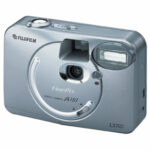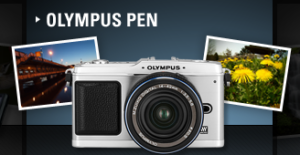
Like a lot of people, I started with a very simple point-and-shoot digicam–a Fuji sporting a full 1.3 megapixels–before eventually getting a digital SLR in 2006. Instead of going with a Nikon or Canon, I decided to take a chance on Sony’s very first dSLR introduced after acquiring Konica-Minolta’s camera division, the a100. Although I had a few Nikon lenses to go with some old film SLRs, I didn’t think my investment in glass was substantial enough to make a Nikon dSLR necessary.

I can find things to quibble about in the a100, but I’ve been quite happy using it for the last three and a half years. No gadget is ever perfect, and a good photographer learns his way around his camera. I’m quite familiar with its operation and quirks, and satisfied with the images I obtain. I don’t use this camera professionally, but I’ve built up a small collection of nice lenses. Aside from the fact that newer models offer lower noise at high ISOs in lower light, and have higher resolution, I’m not particularly tempted to trade in my old a100 yet.
 However, I have been quite tempted by the new compact mirrorless interchangeable lens cameras in the micro-four/thirds mount like the Olympus Pen series and the Panasonic GF-1. They offer image quality on par with dSLRs in bodies closer to the size of larger point-and-shoot cameras. I’m tempted because I like having a compact digital camera, but have been generally disappointed with their image quality. They tend to be fine for casual shots in daylight, but suffer quite a bit in anything dimmer. Furthermore, as I’ve become a more experienced photographer I like to use manual controls and these are often missing or very limited on digital point-and-shoots.
However, I have been quite tempted by the new compact mirrorless interchangeable lens cameras in the micro-four/thirds mount like the Olympus Pen series and the Panasonic GF-1. They offer image quality on par with dSLRs in bodies closer to the size of larger point-and-shoot cameras. I’m tempted because I like having a compact digital camera, but have been generally disappointed with their image quality. They tend to be fine for casual shots in daylight, but suffer quite a bit in anything dimmer. Furthermore, as I’ve become a more experienced photographer I like to use manual controls and these are often missing or very limited on digital point-and-shoots.
Then at this year’s Consumer Electronics Show Sony previewed a new line of interchangeable lens compact cameras to add to its Alpha line. I’ve been cautiously excited as various details were rumored and leaked. Today the real cameras were announced, and I’m a little disappointed.

Unfortunately, there are two big minuses that dump some cold water on my enthusiasm. The biggest drawback is that they don’t have in-body image stabilization. Given that this was why I chose a Sony dSLR in the first place, this is a big disappointment. By comparison, all the Olympus Pen cameras have in-body IS, although the Panasonics do not. I understand that the NEXs lack IS so Sony could make the camera bodies thinnner. But, I, for one, would gladly take a slightly thicker camera in exchange for the IS.
To be fair, Sony plans to offer lenses with IS to fit the NEX cameras, just like Panasonic does for its micro-4/3 cameras. However, Sony isn’t putting IS in all their lenses, and the first two being offered don’t have it.
The second minus is that the cameras use a new lens mount, meaning Sony’s A-mount dSLR lenses don’t work without an adapter. Now, I was expecting this possibility, since micro-4/3 was a new mount requiring an adapter to use older Olympus and Panasonic dSLR lenses. So by itself, this isn’t a huge deal. But the adapter won’t support autofocus using the Sony dSLR lenses. To me, this significantly undercuts what could be a big advantage of choosing a Sony NEX camera–the ability to leverage my existing Alpha lenses.
Because of the unique design advantages of these mirrorless interchangeable compacts, a thriving aftermarket in lens adapters has sprung up. Now you can get adapters for an Olympus Pen or Panasonic GF-1 what will allow you to use just about any 35mm lens in existence. The caveat with these adapters is that they also don’t support autofocus.
But I can actually get a Sony lens adapter for an Olympus E-PL1, which has in-body image stabilization, my most coveted feature. Given that, why would I buy a Sony NEX 3 or 5 which offers no better Alpha lens compatibility and lacks image stabilization?
That said, the NEXs aren’t in stores yet and I haven’t had my hands on them. The preliminary hands-on previews and reviews I’ve ready are generally positive. There’s mostly praise for the cameras’ size and the handling, along with good reports on image quality. Based on some image samples I’ve seen, four years of sensor advancement give much better low-light ability than my a100 in a body much closer in size to a point-and-shoot.
At the moment I’m quite undecided as to whether I want to take the plunge with an NEX or a competitor like an Olympus Pen. With a few rare exceptions, with tech gadgets you rarely lose by waiting to see what lies around the bend. Sony might introduce follow-up models with in-body IS (though I kind of doubt it) or that can autofocus Alpha-mount lenses (somewhat more likely). Or Olympus might offer up something even more tempting that makes me forget the NEX’s 1080i HD video and better high-ISO performance.
So that means I’m going to wait and see, saving my hard-earned dollars for the moment. It’s fun just watching and having something to look forward to.
Leave a Reply